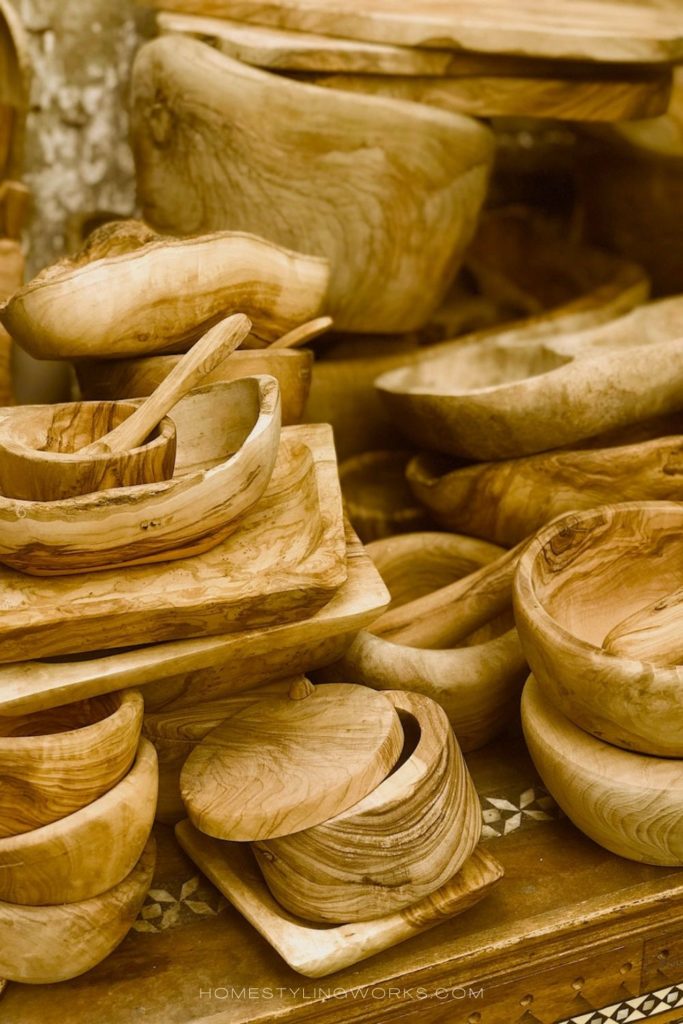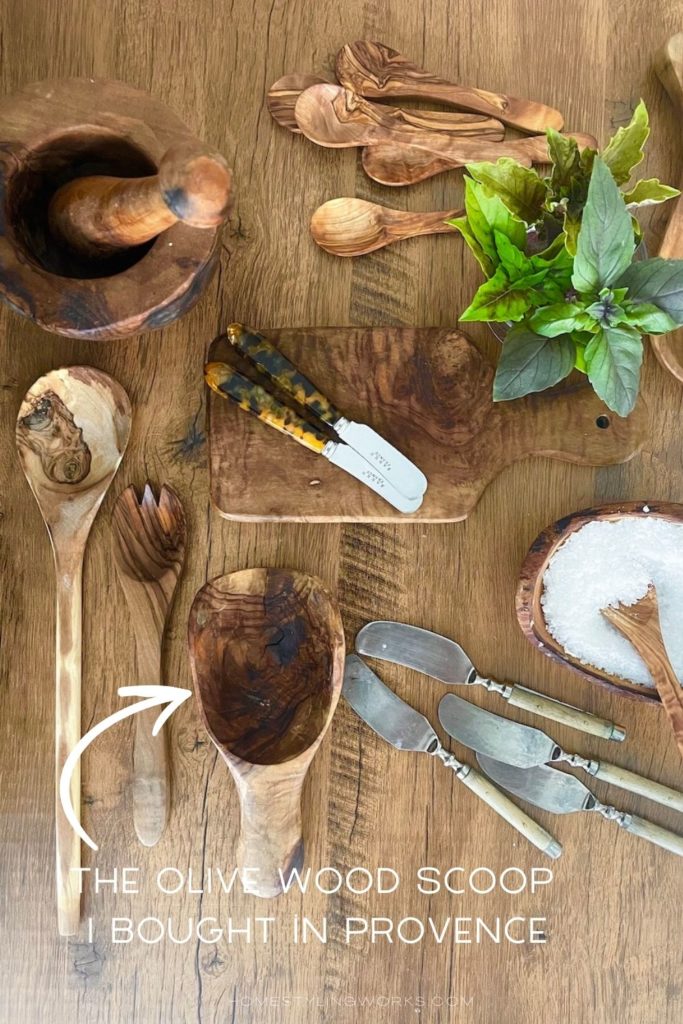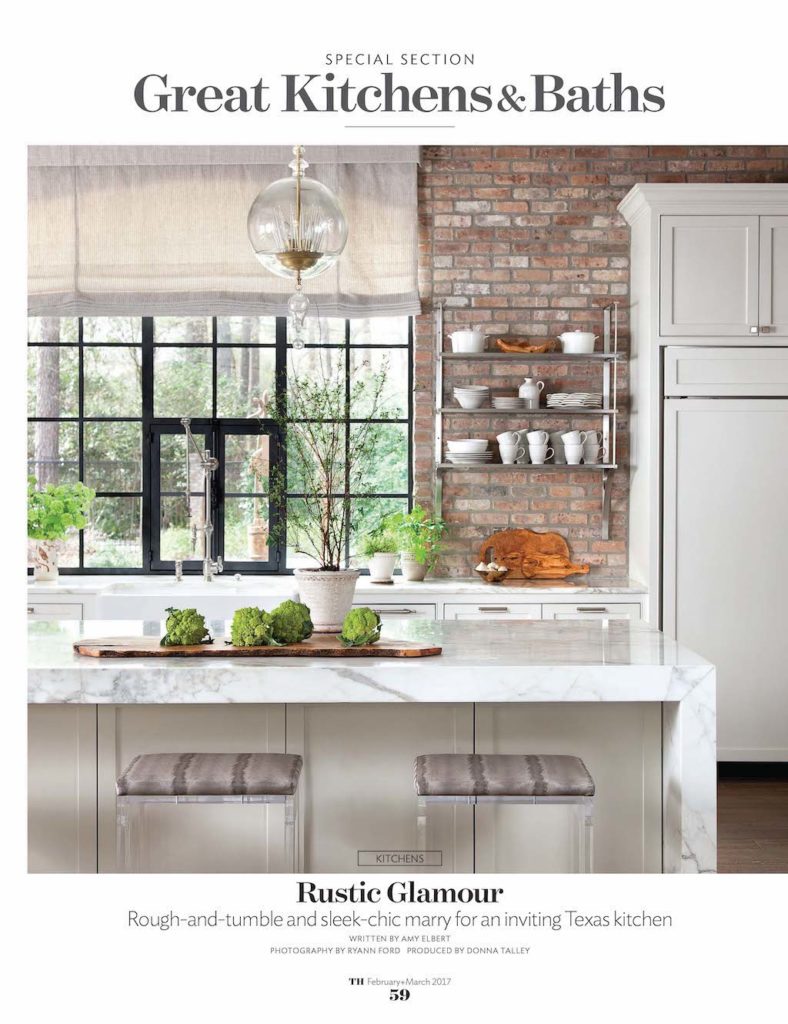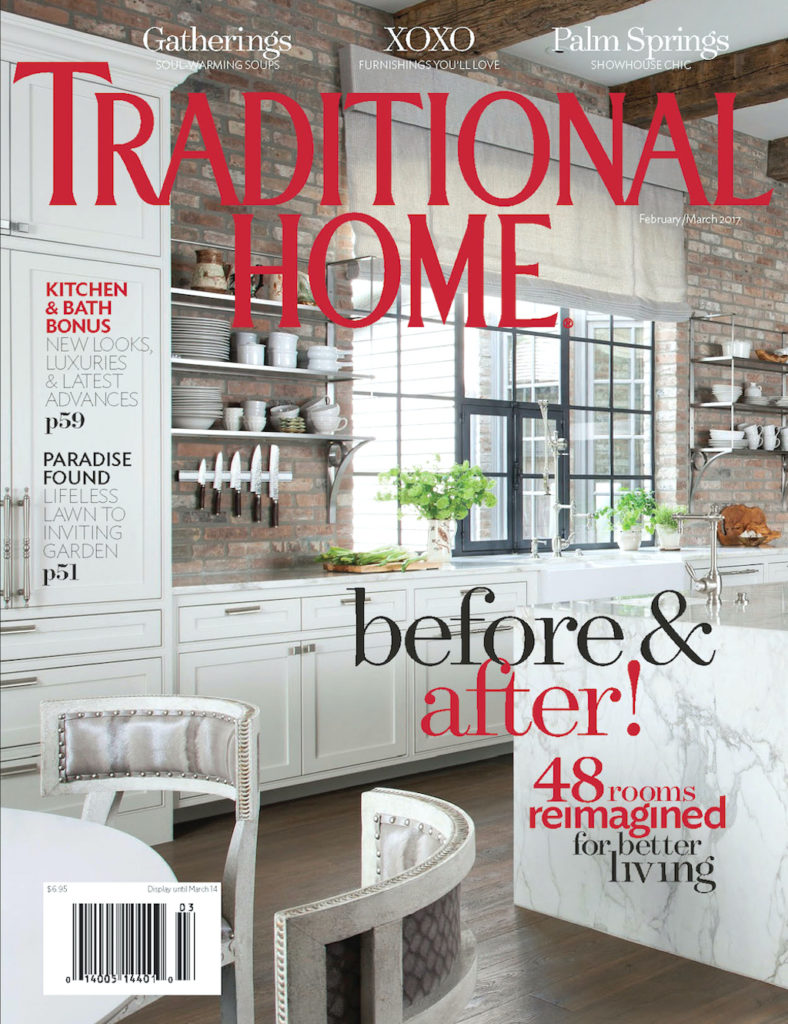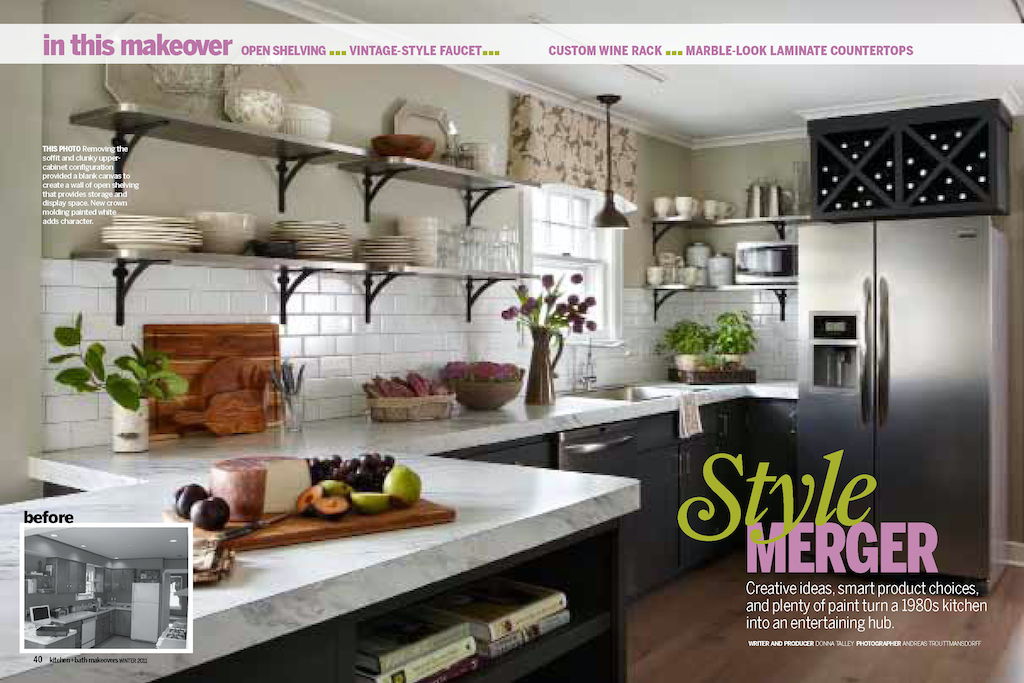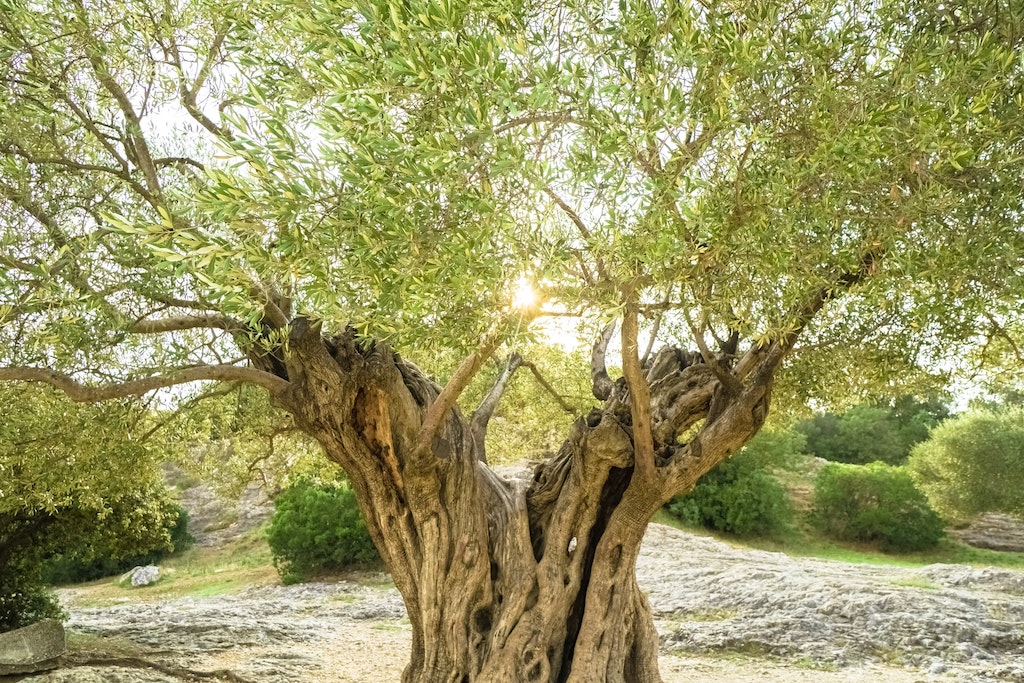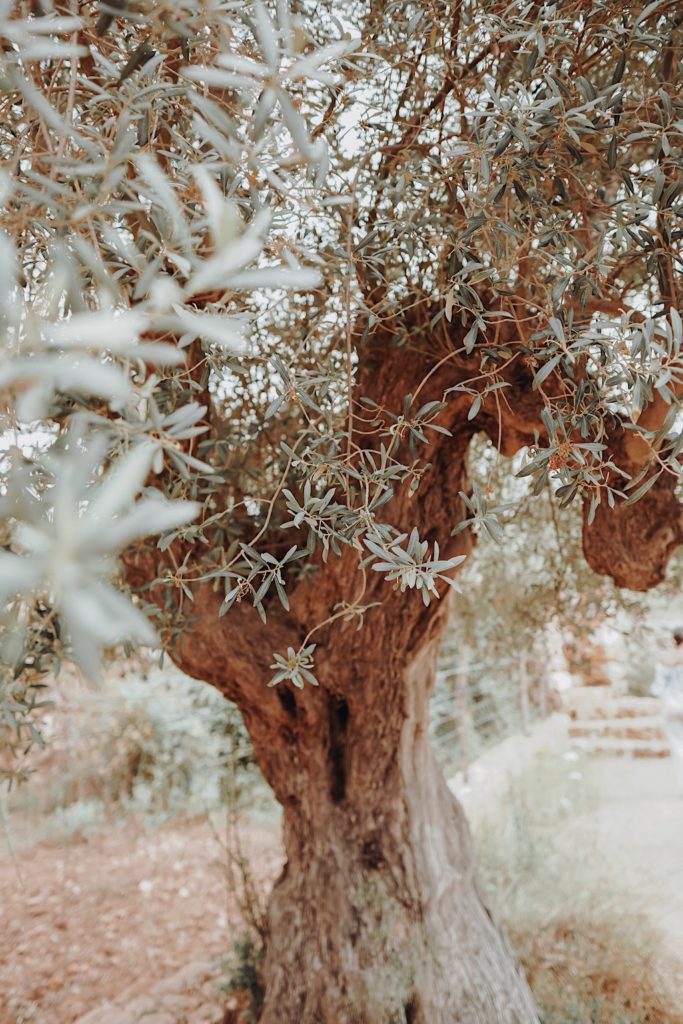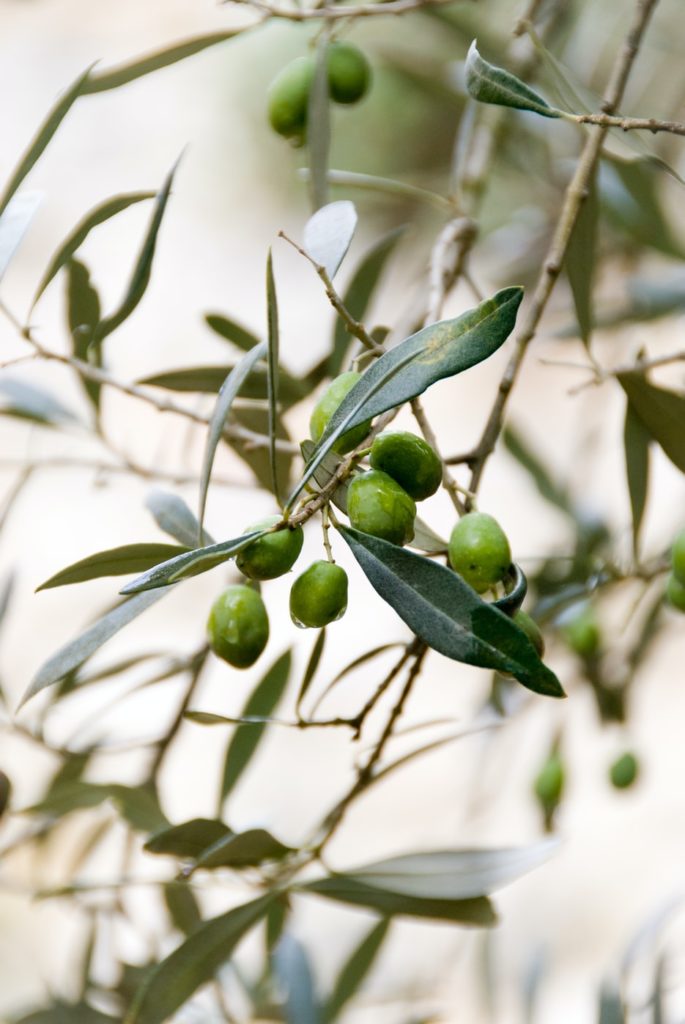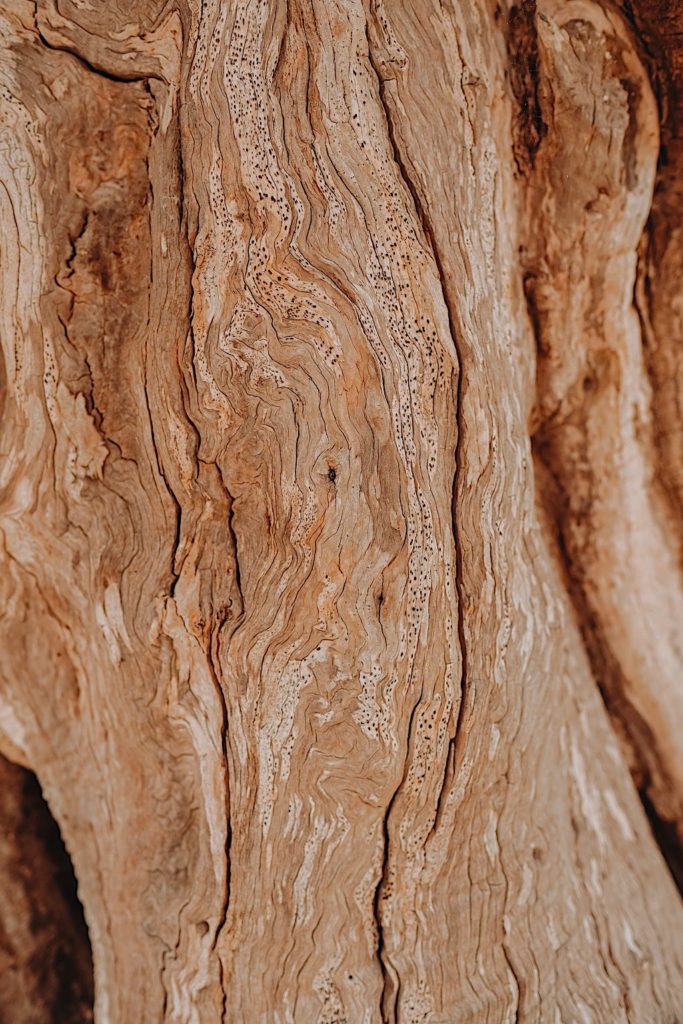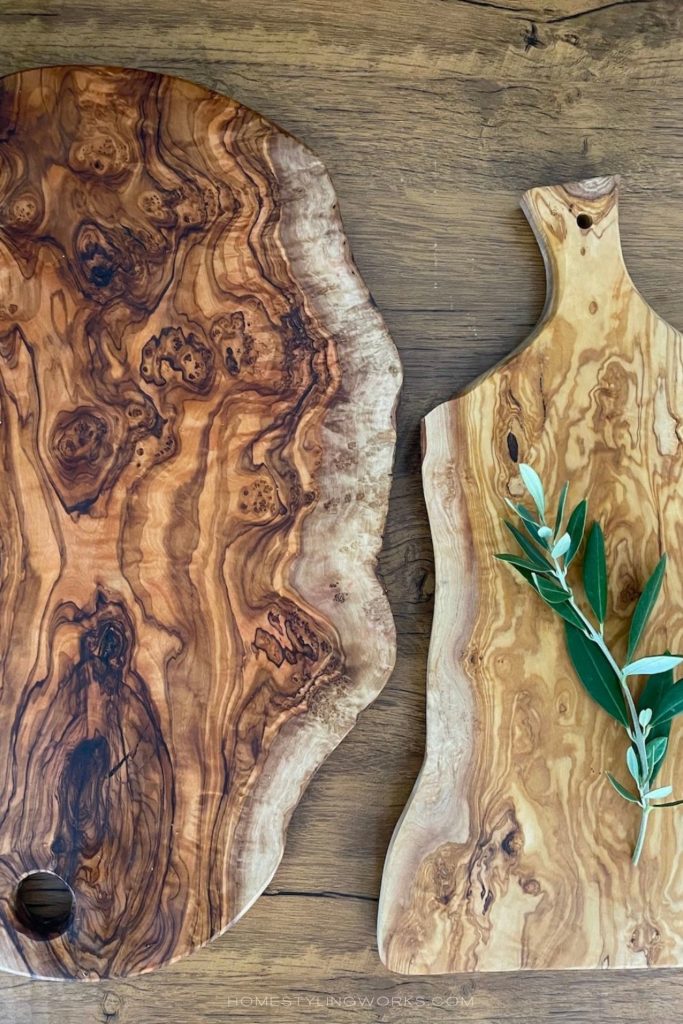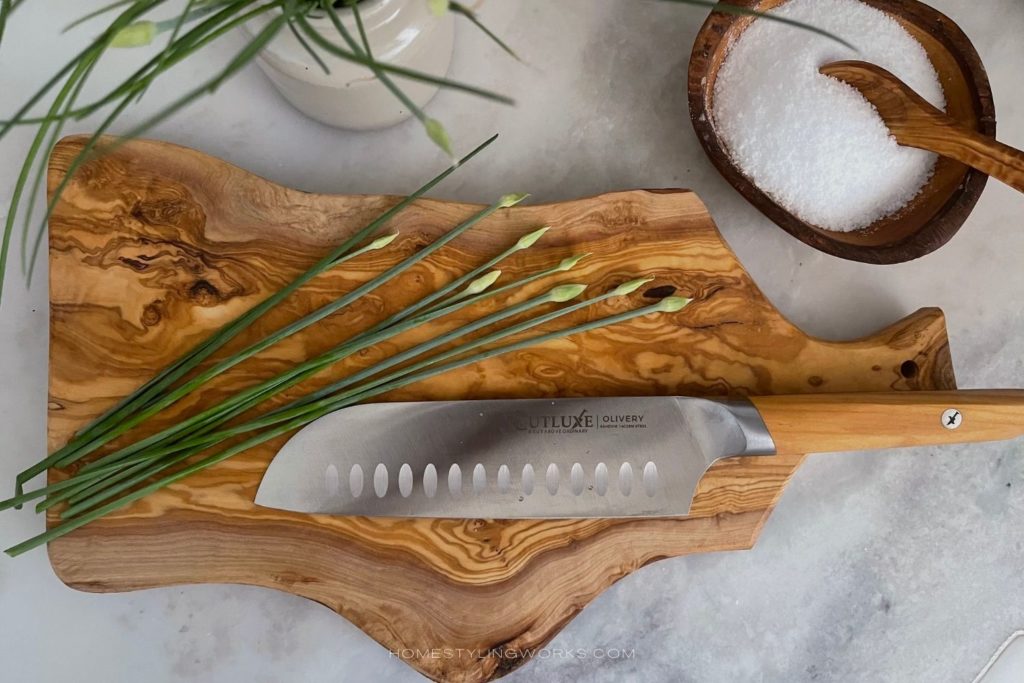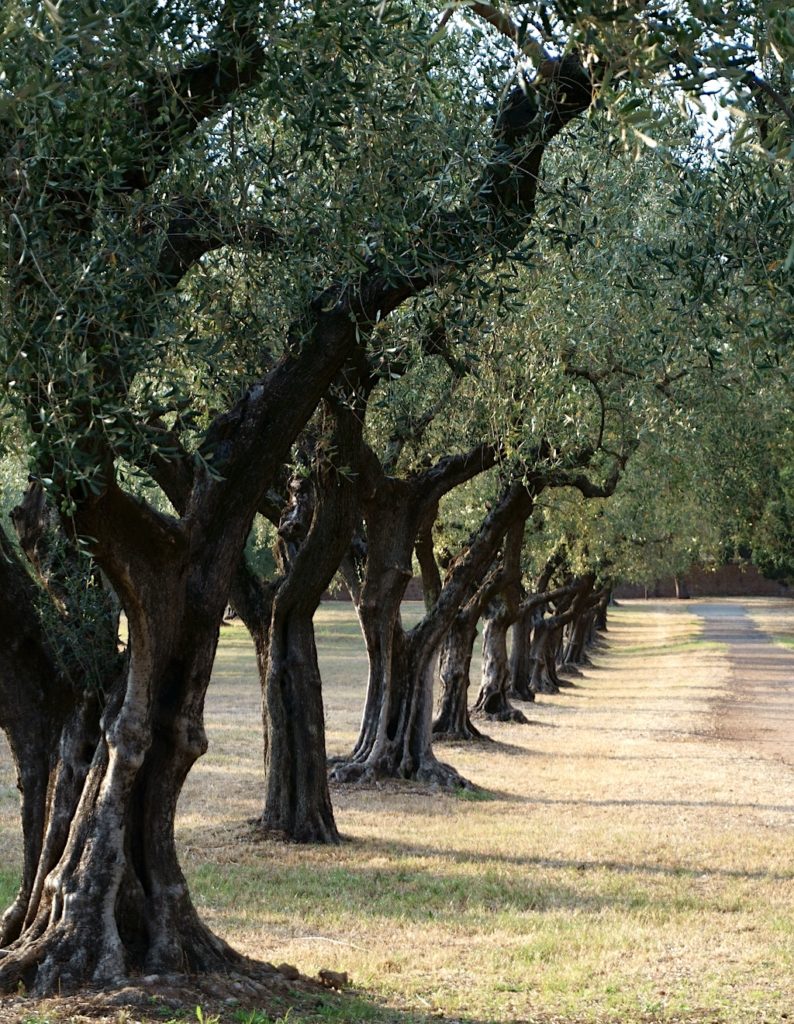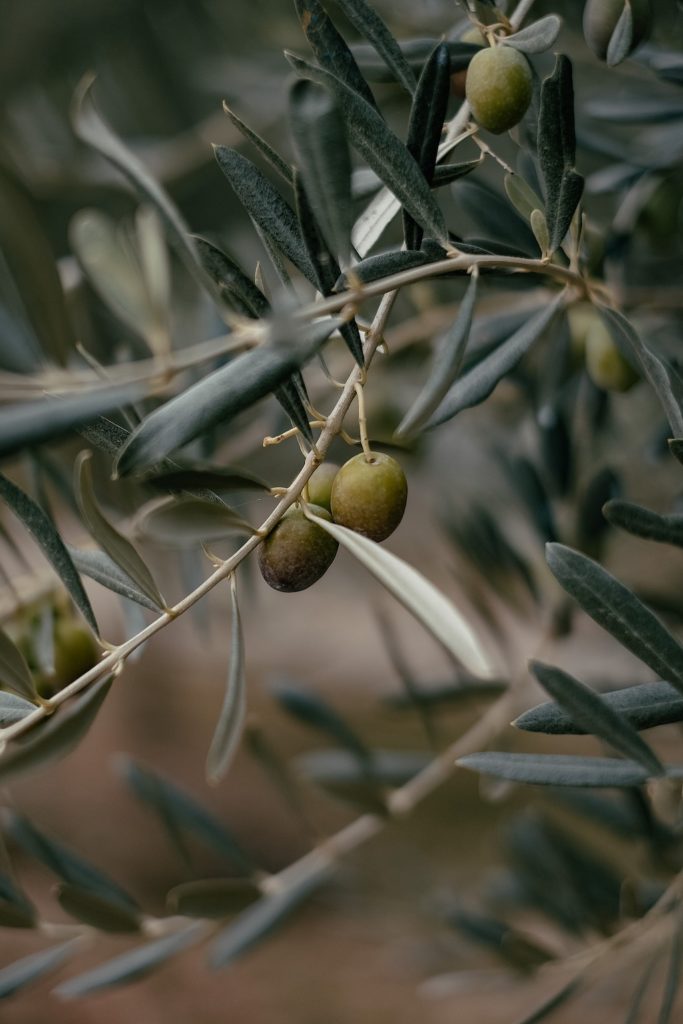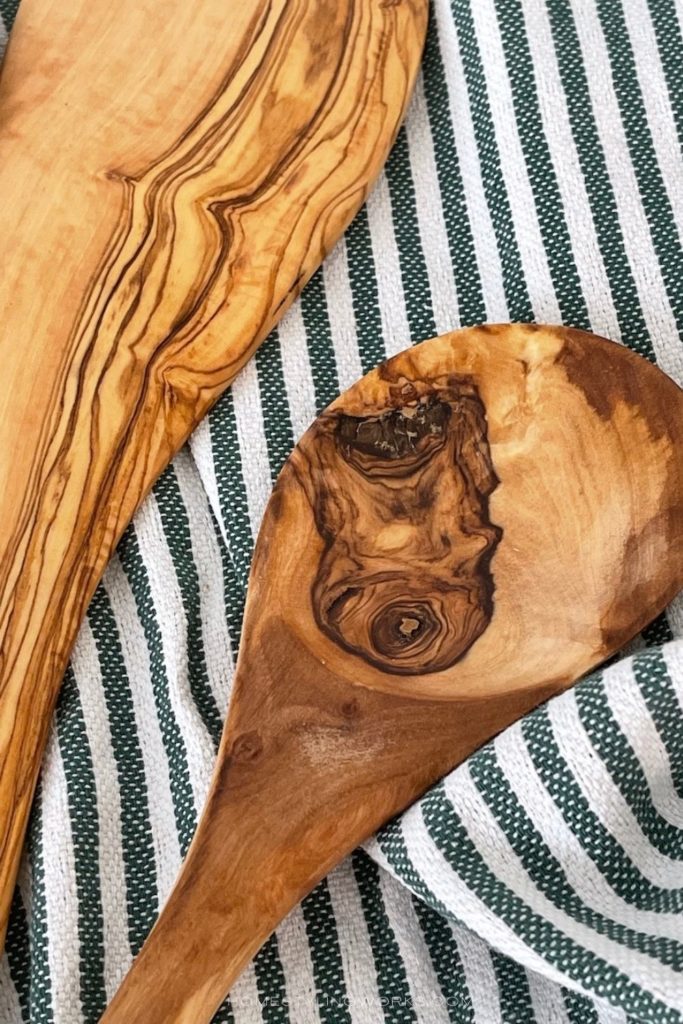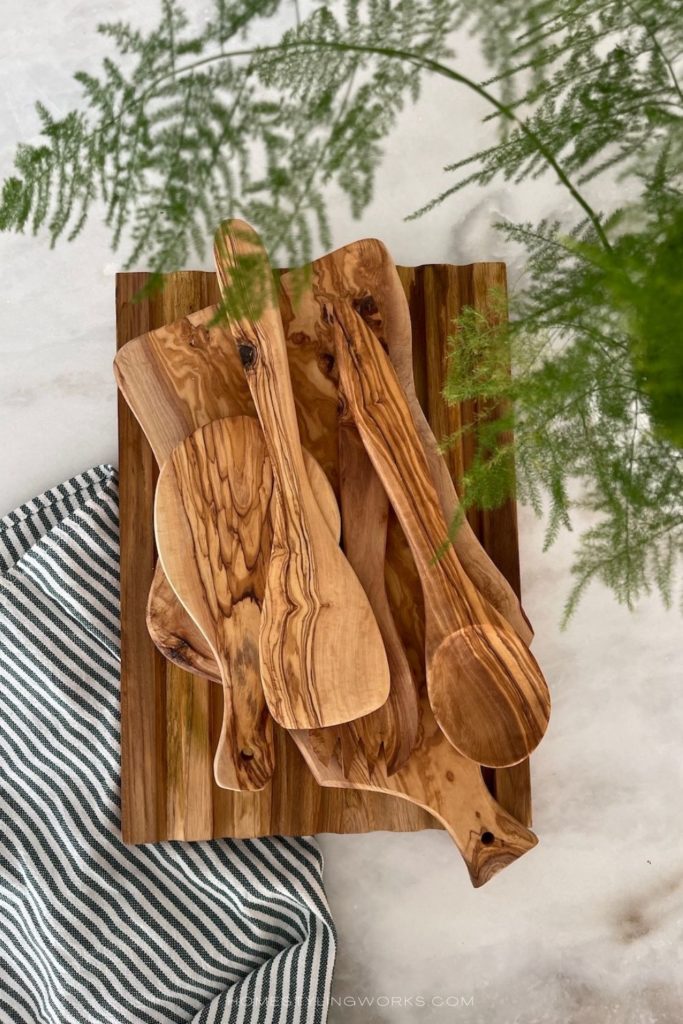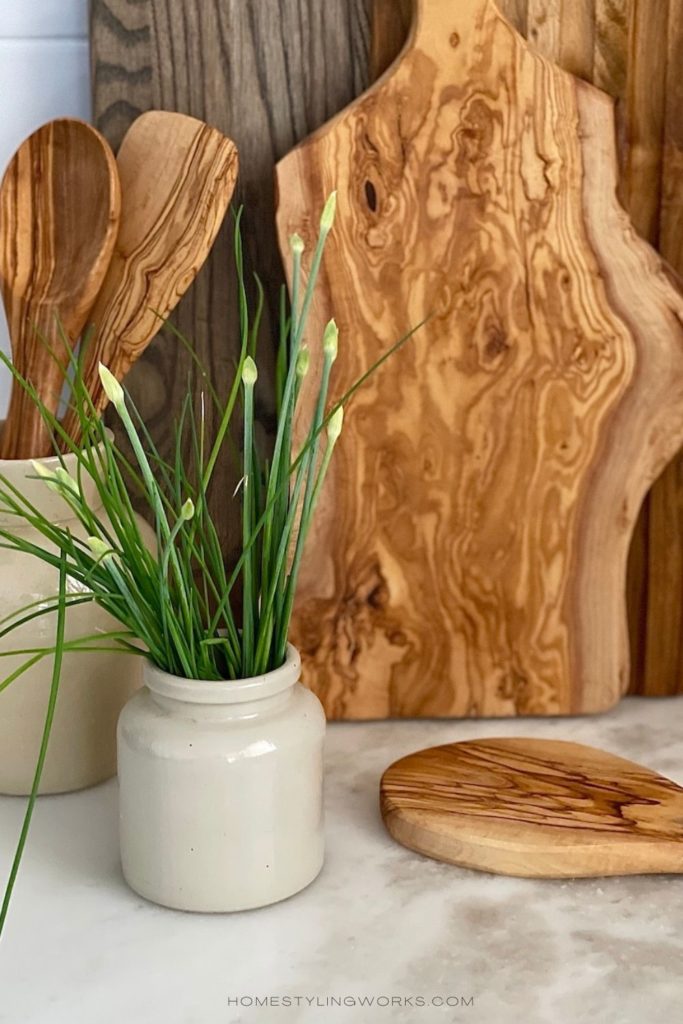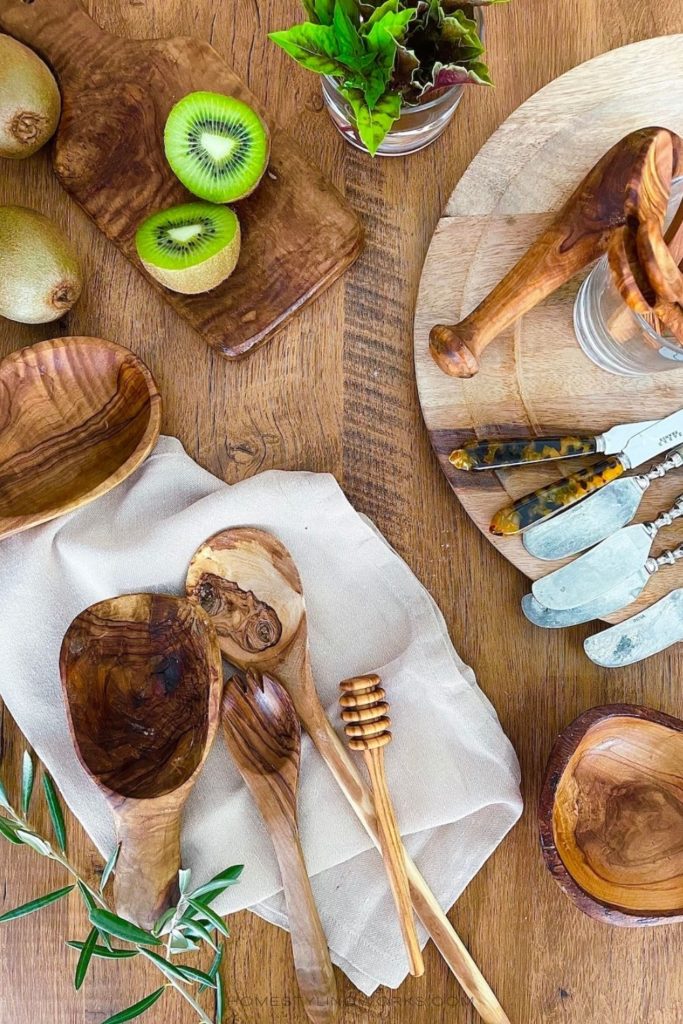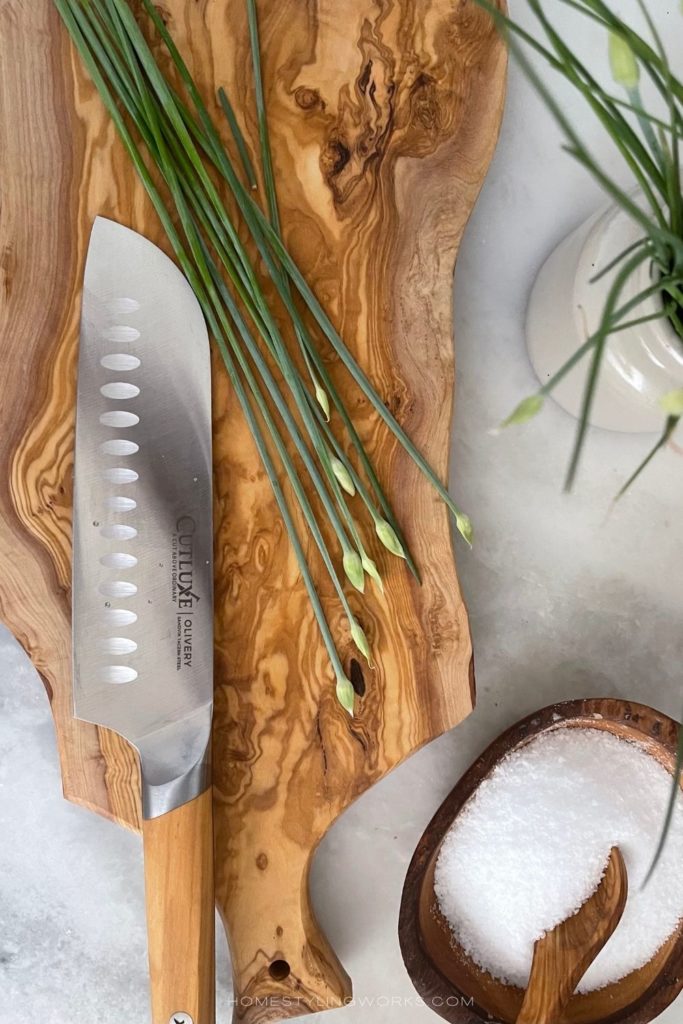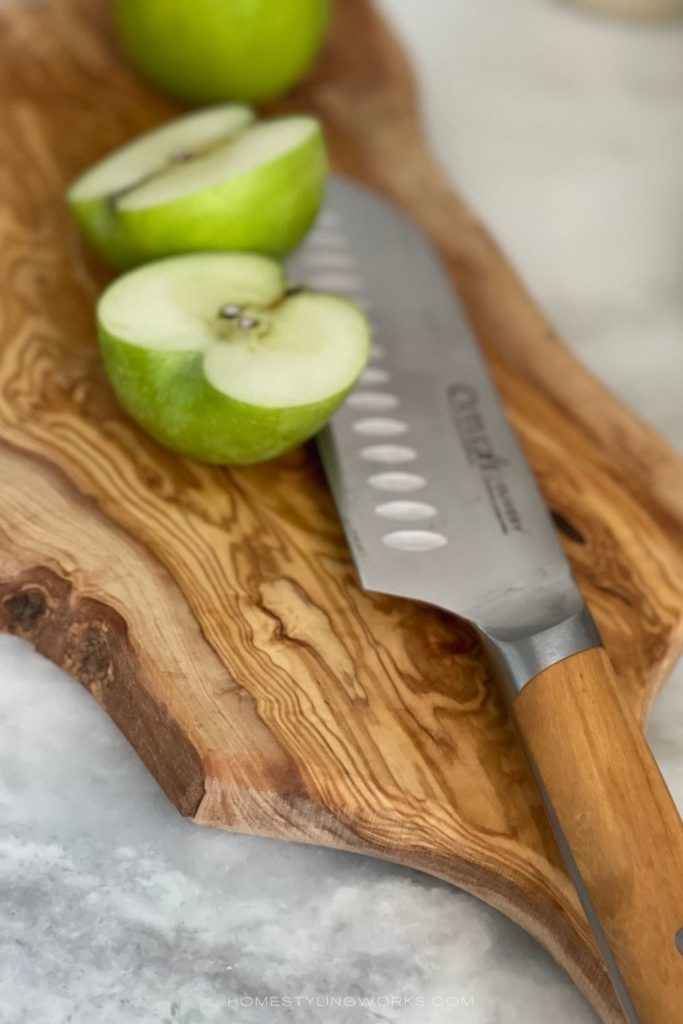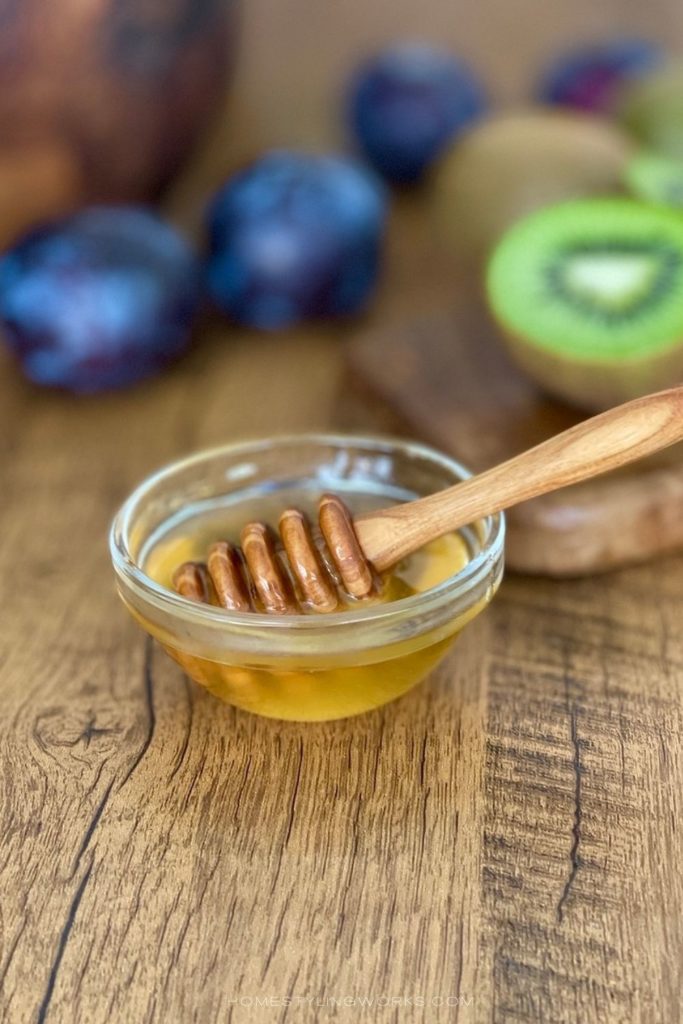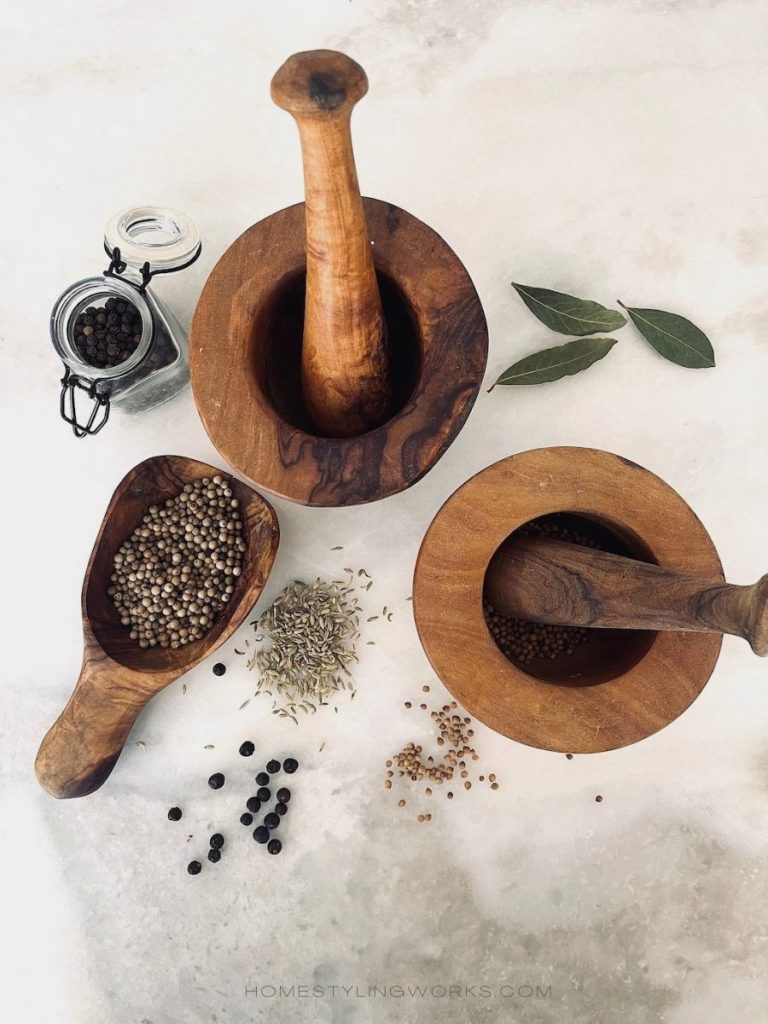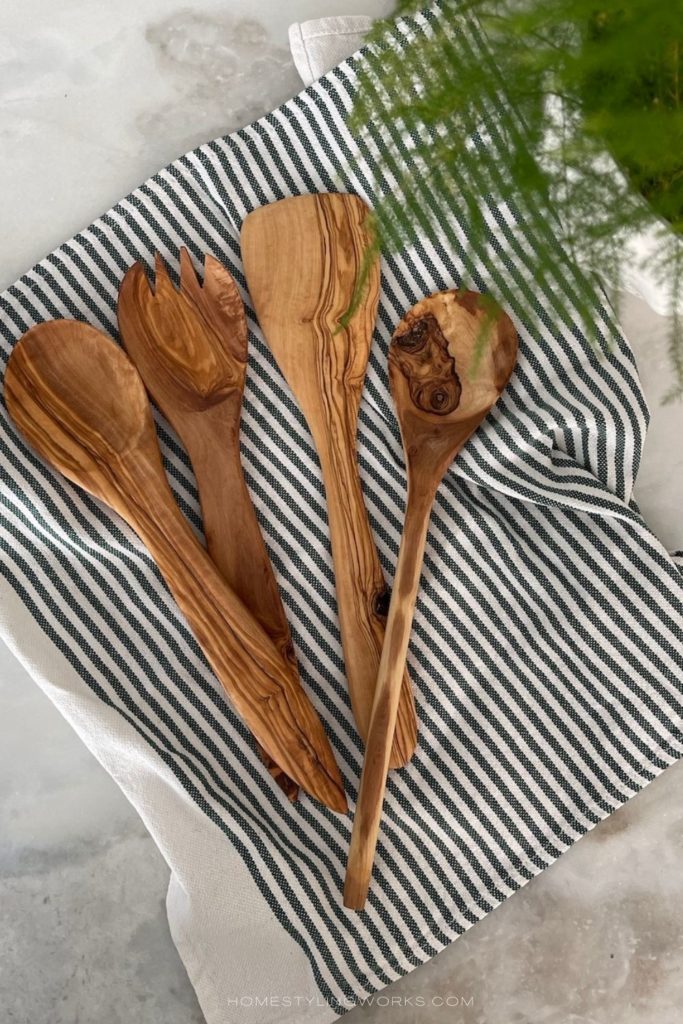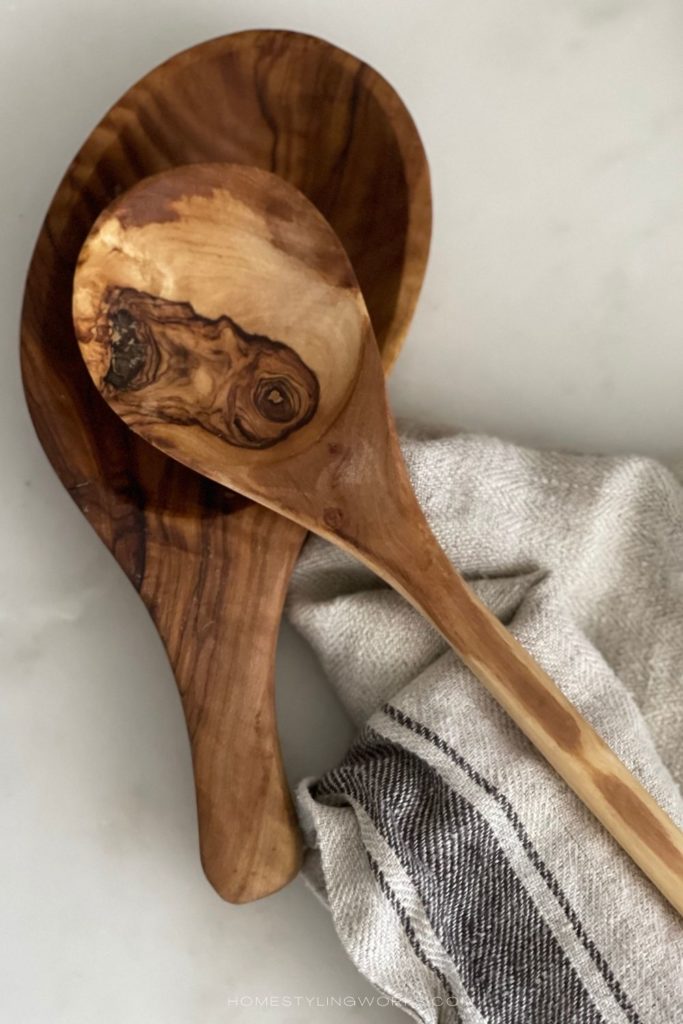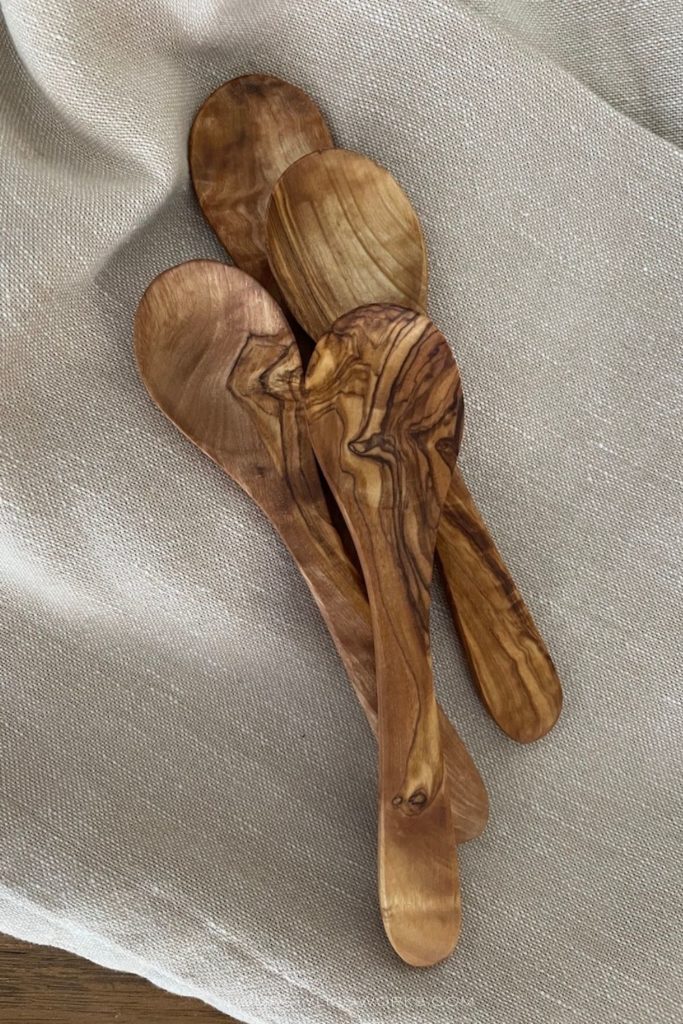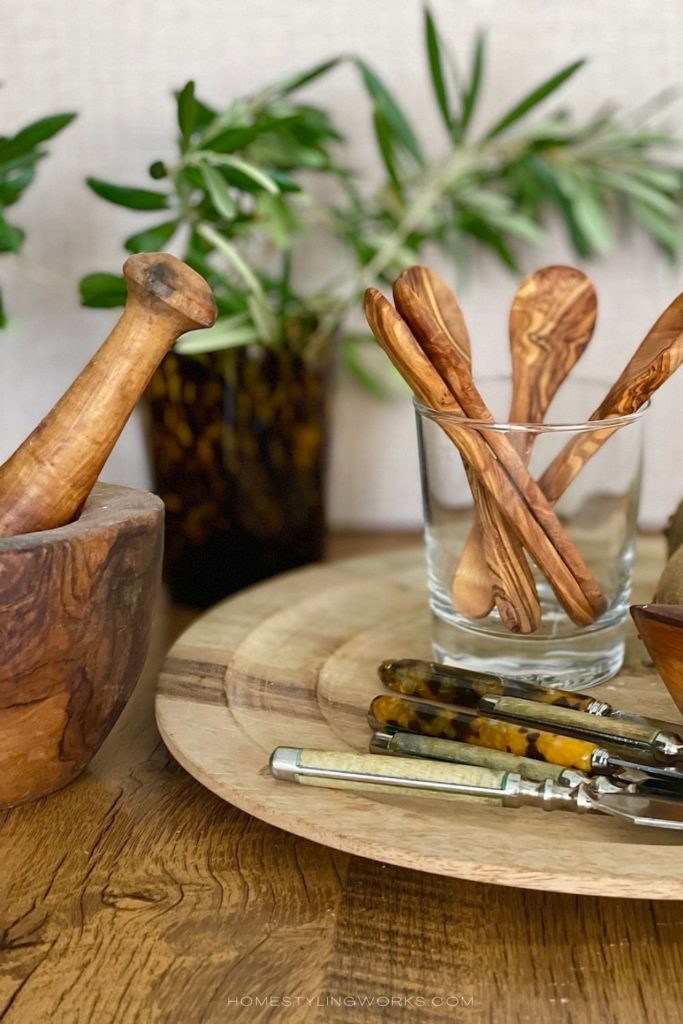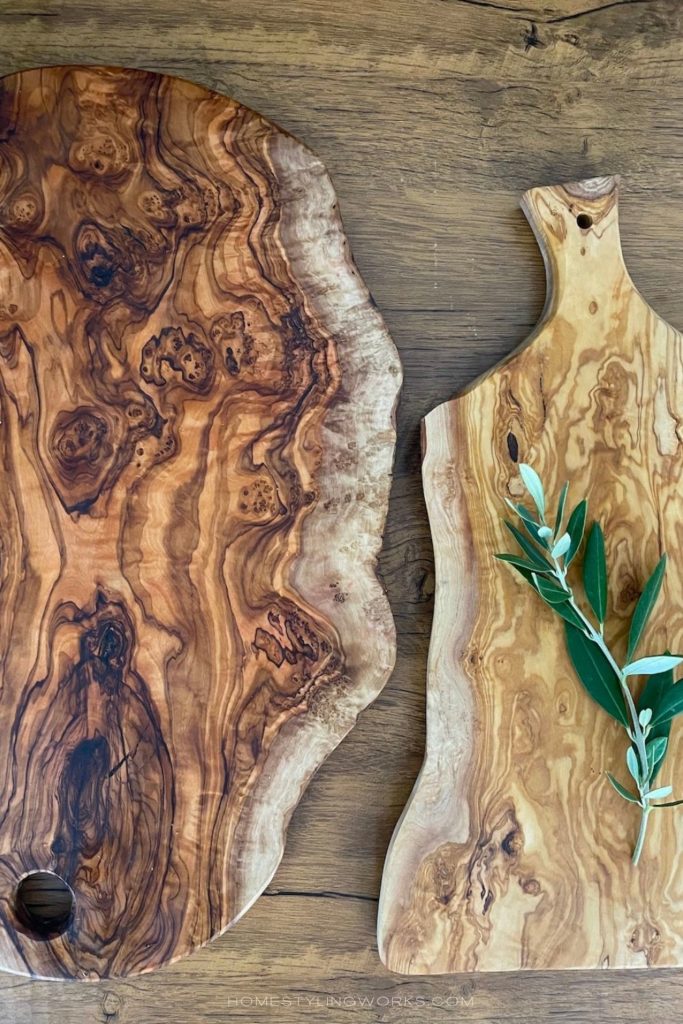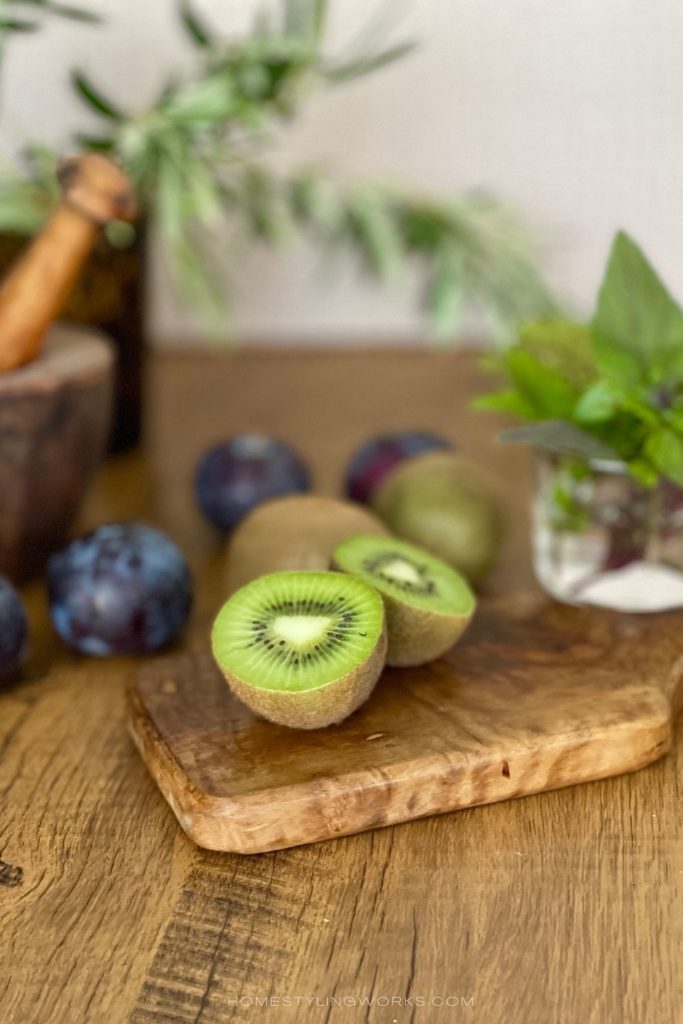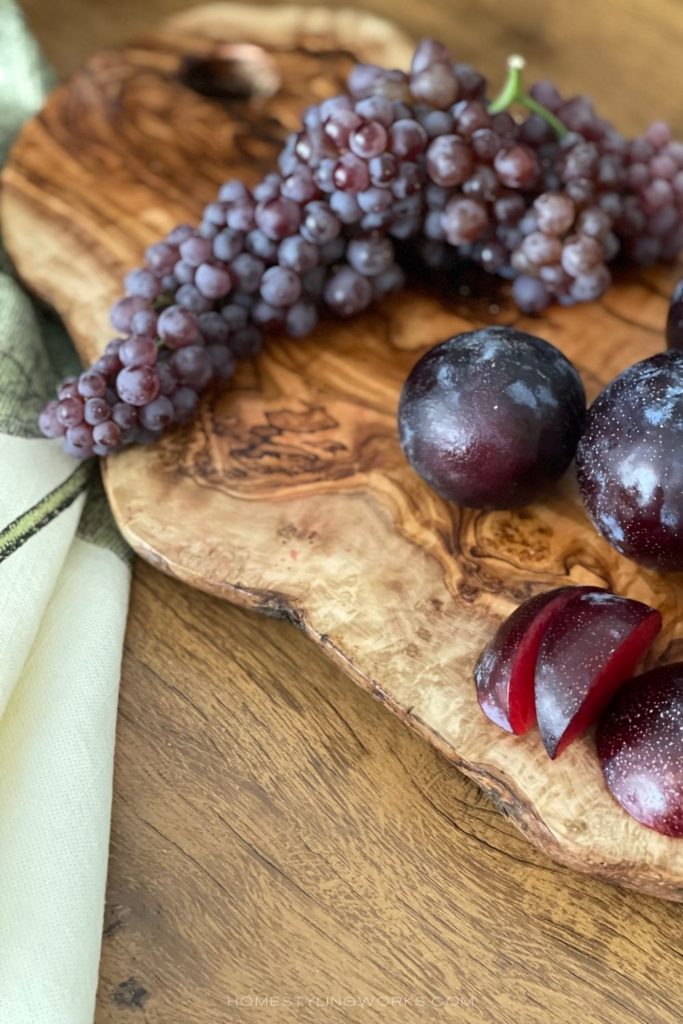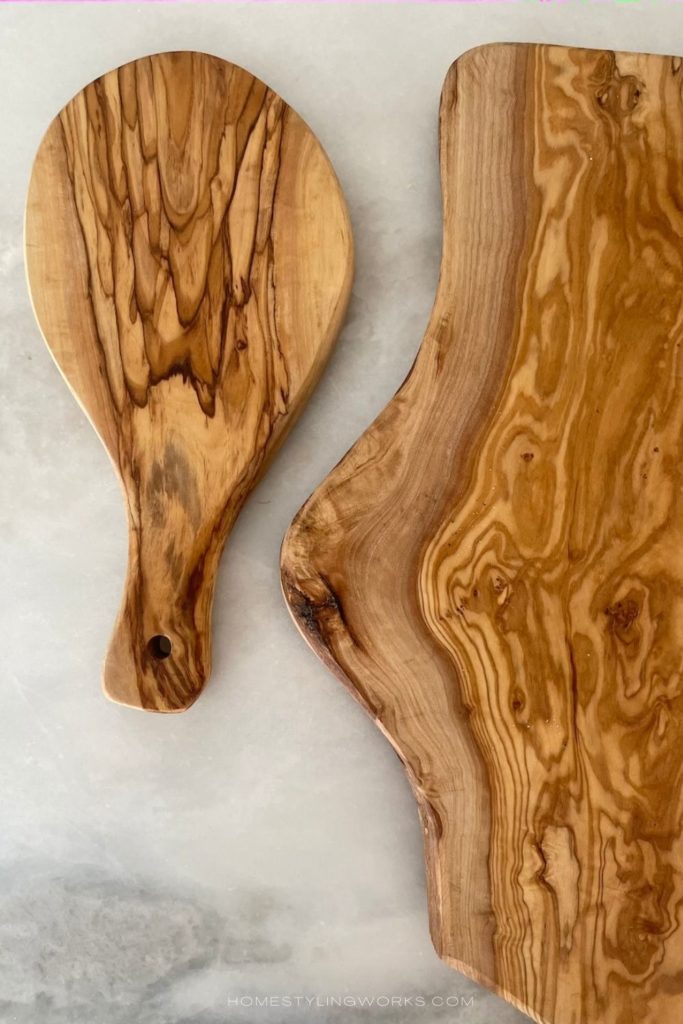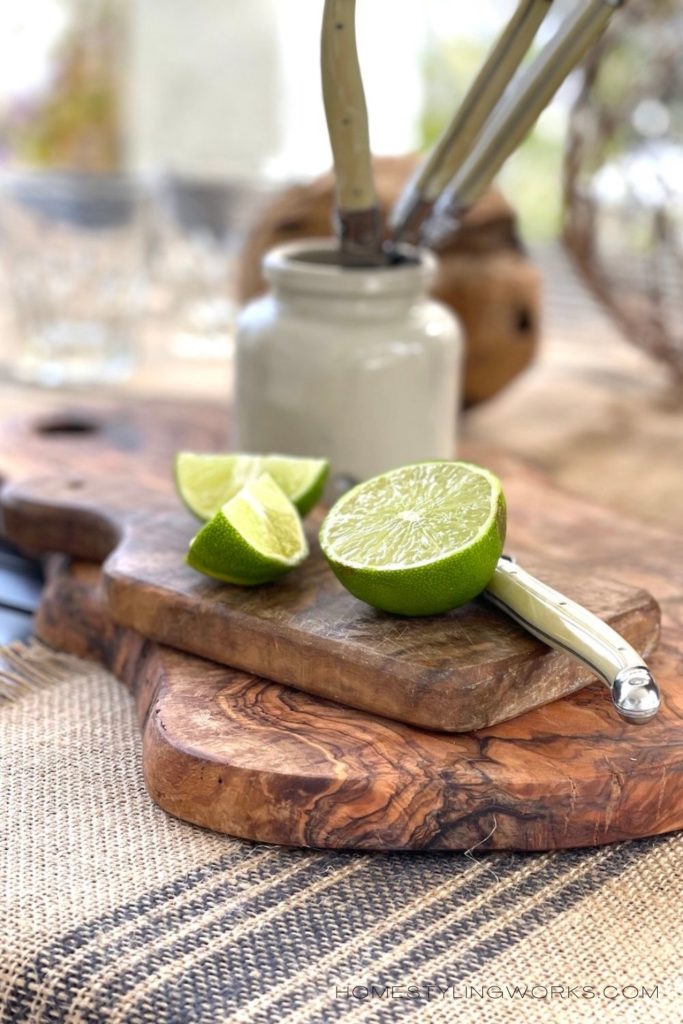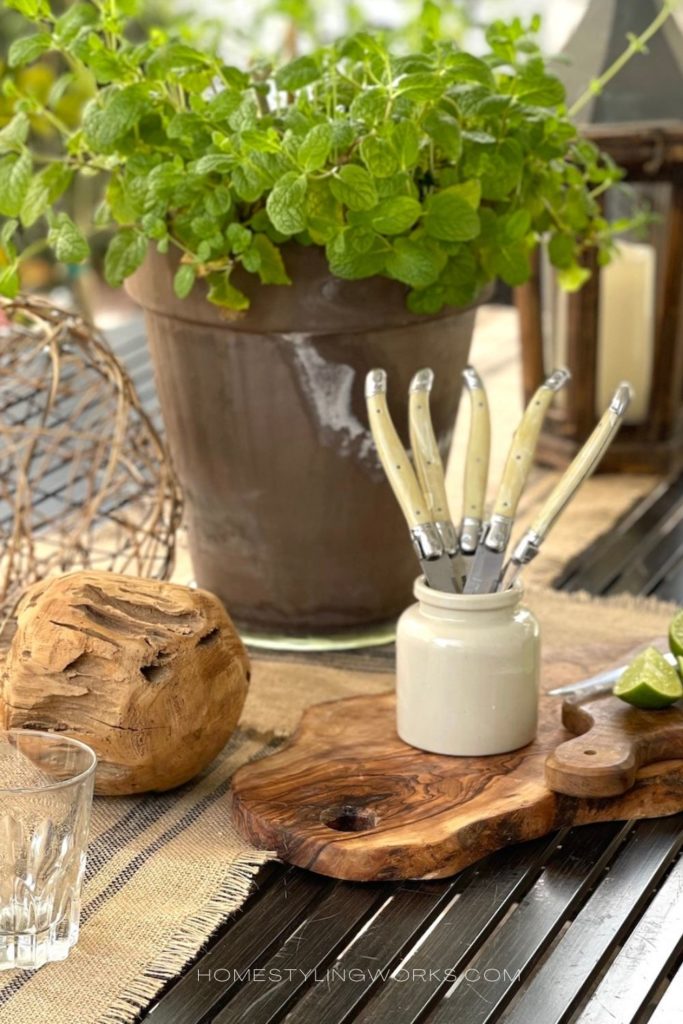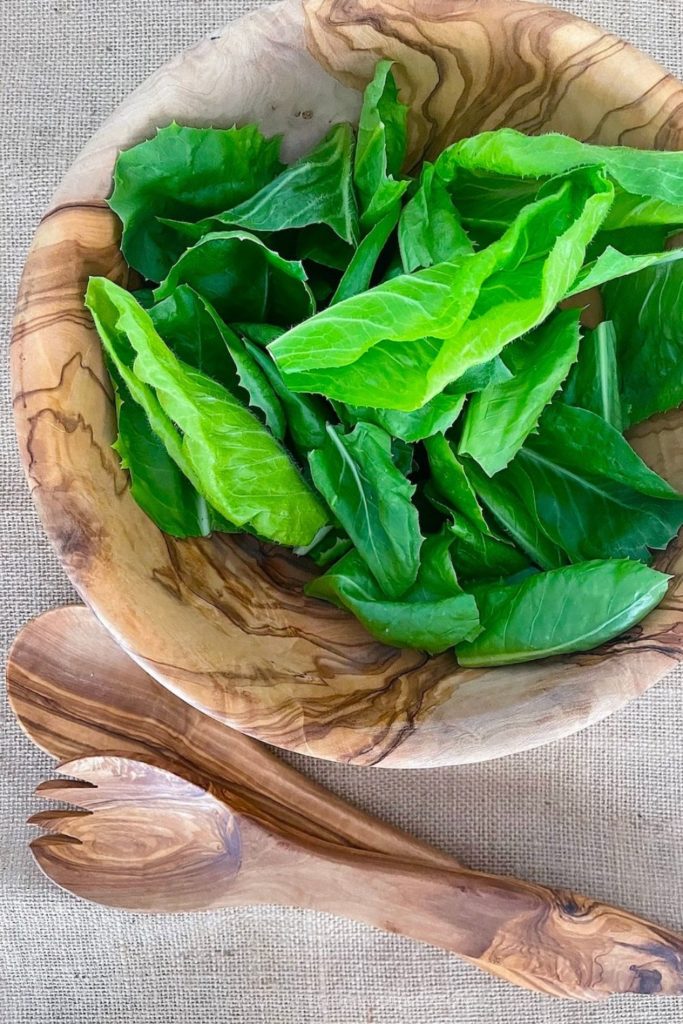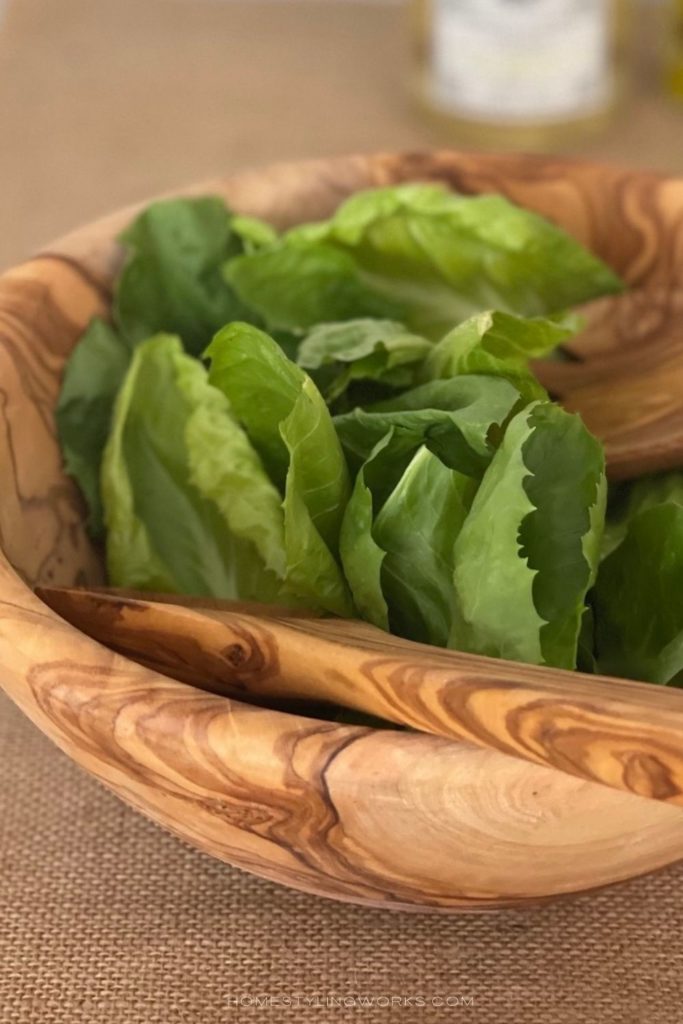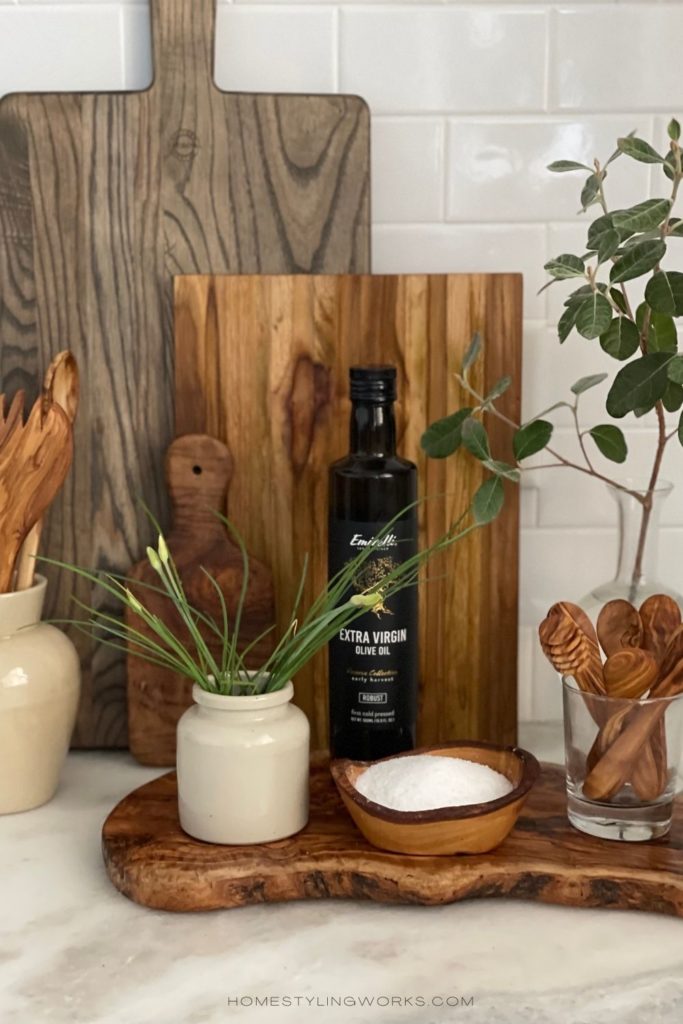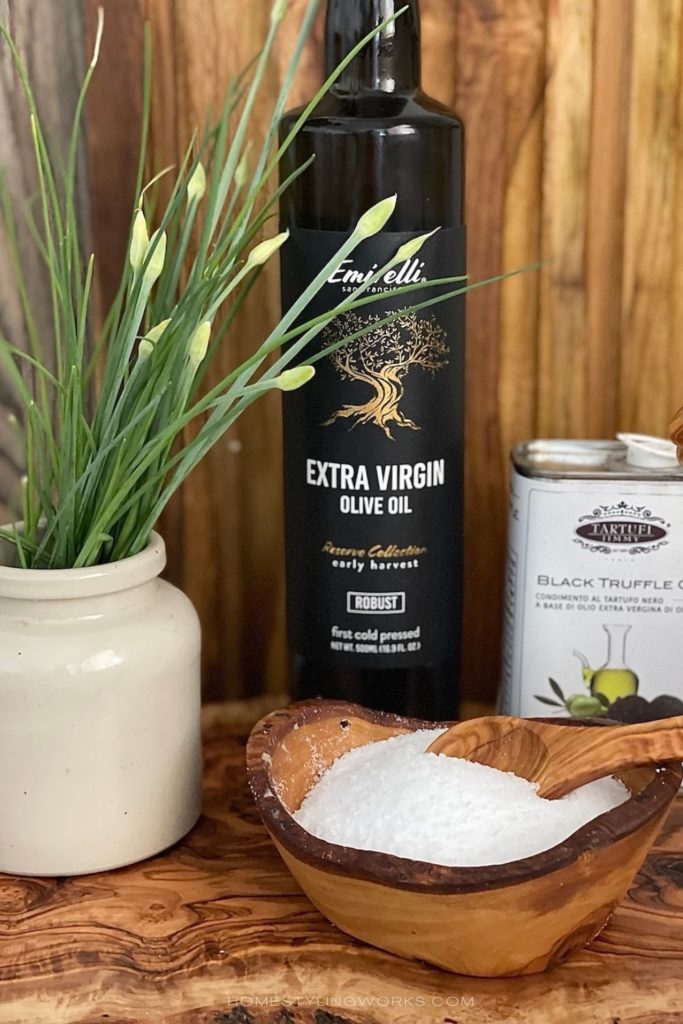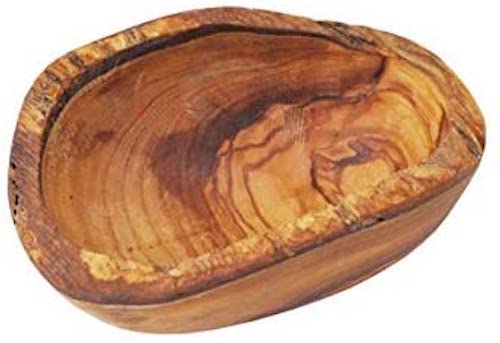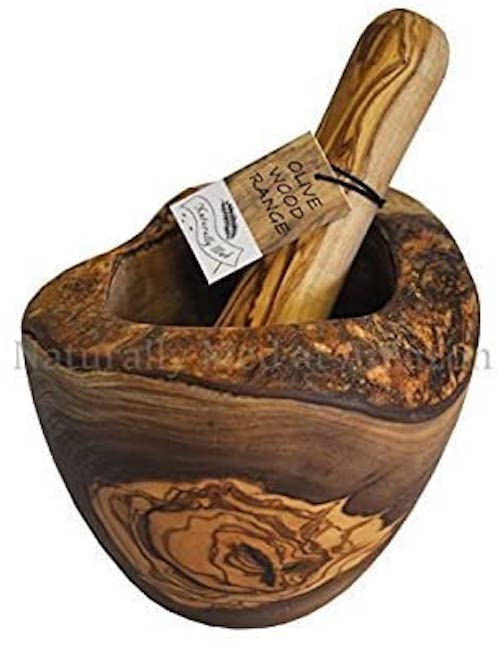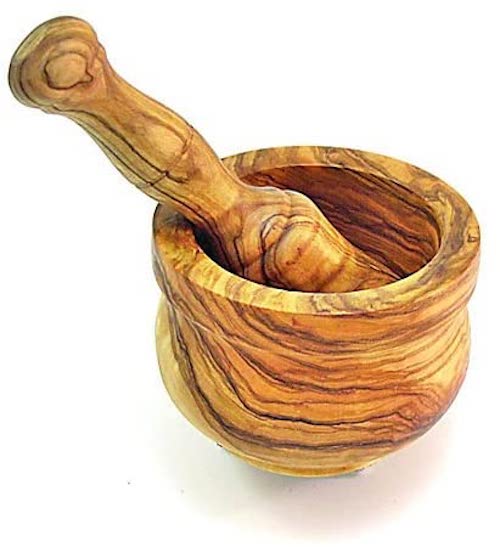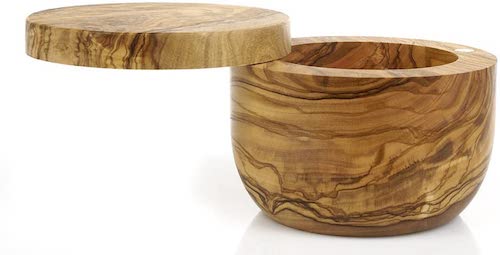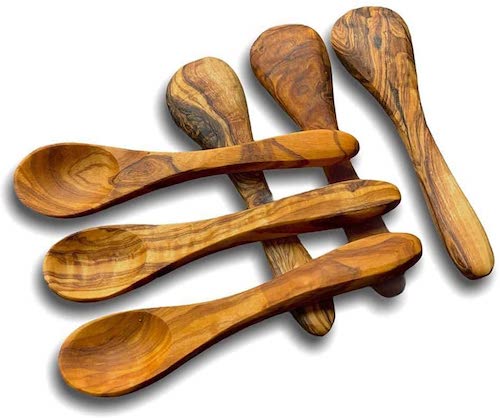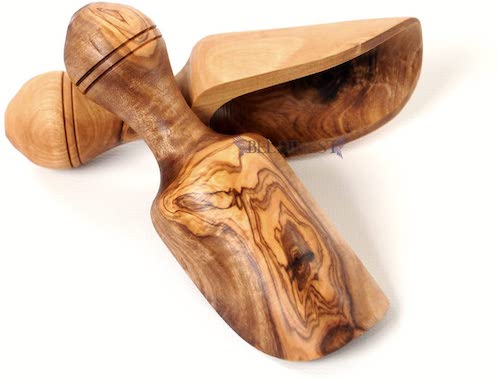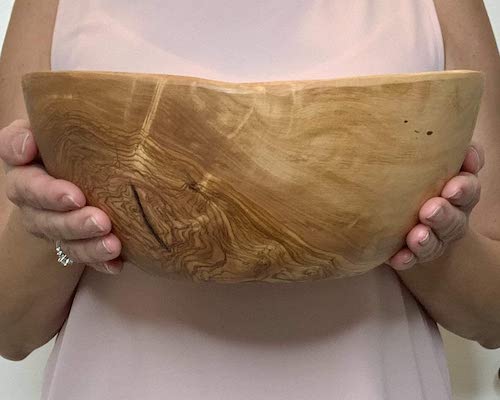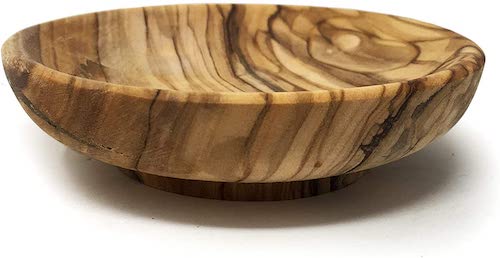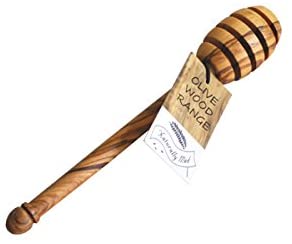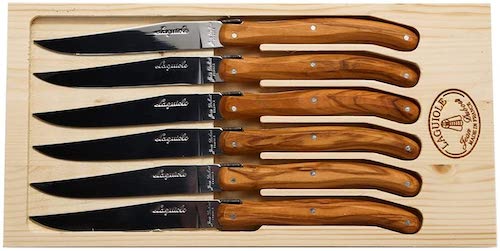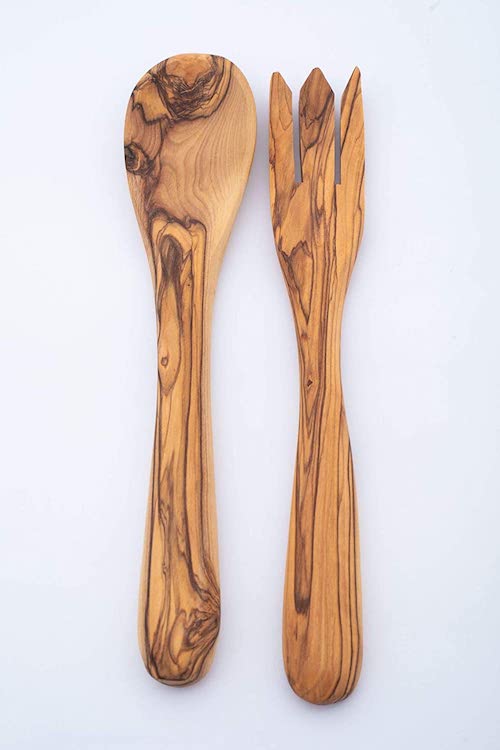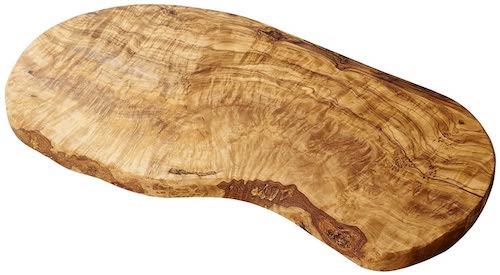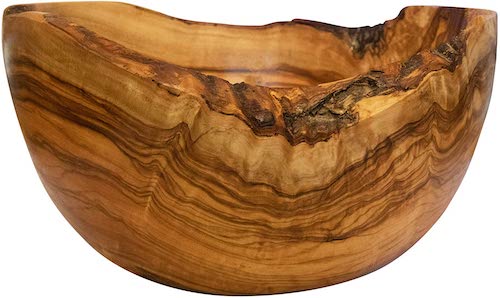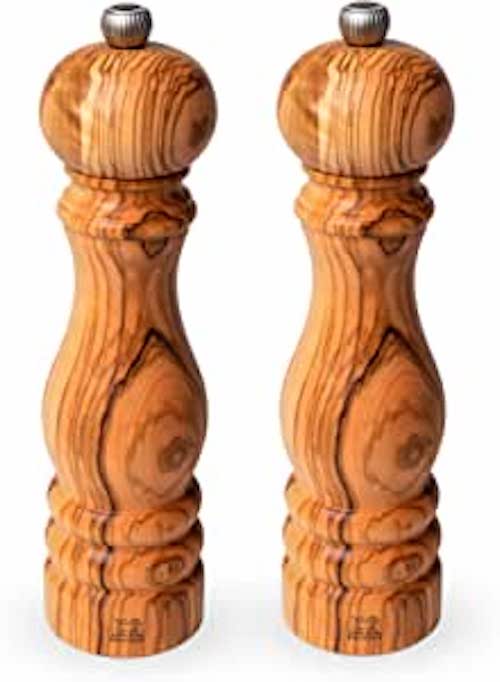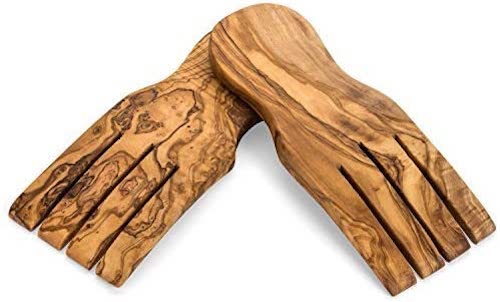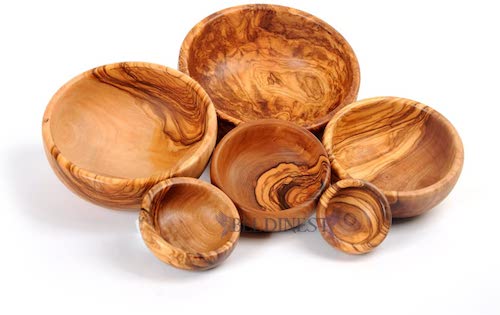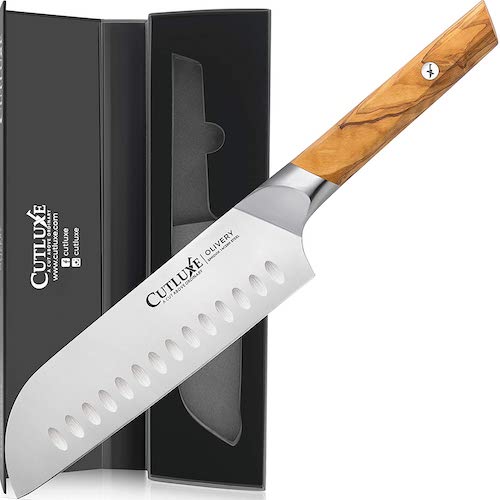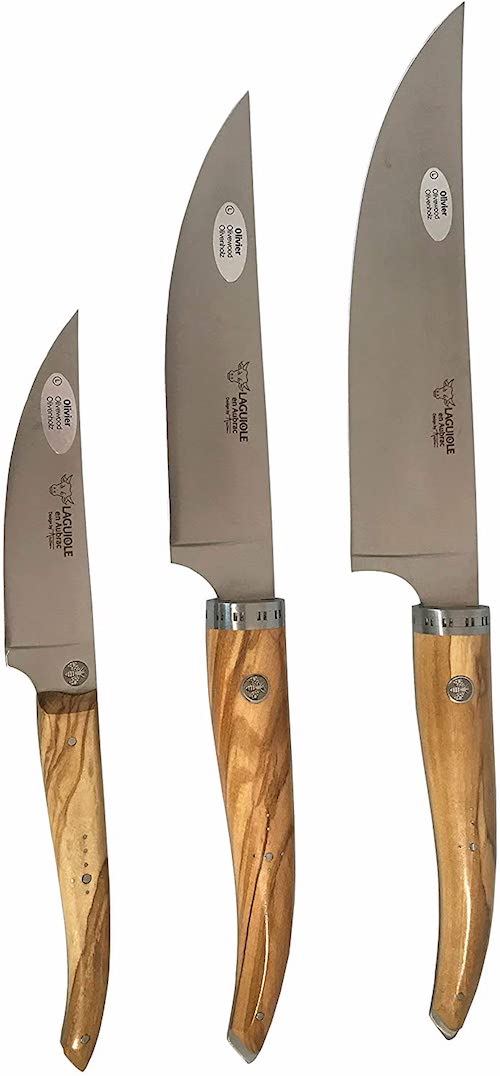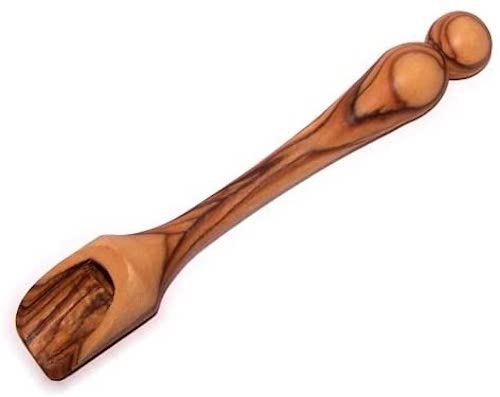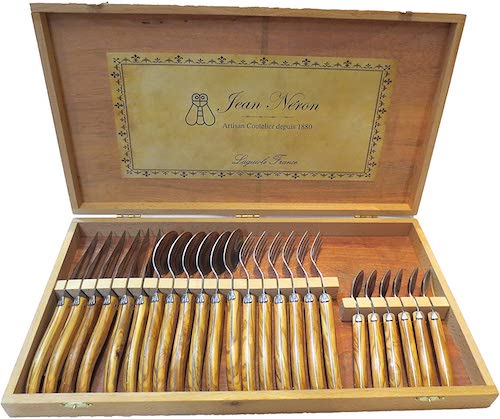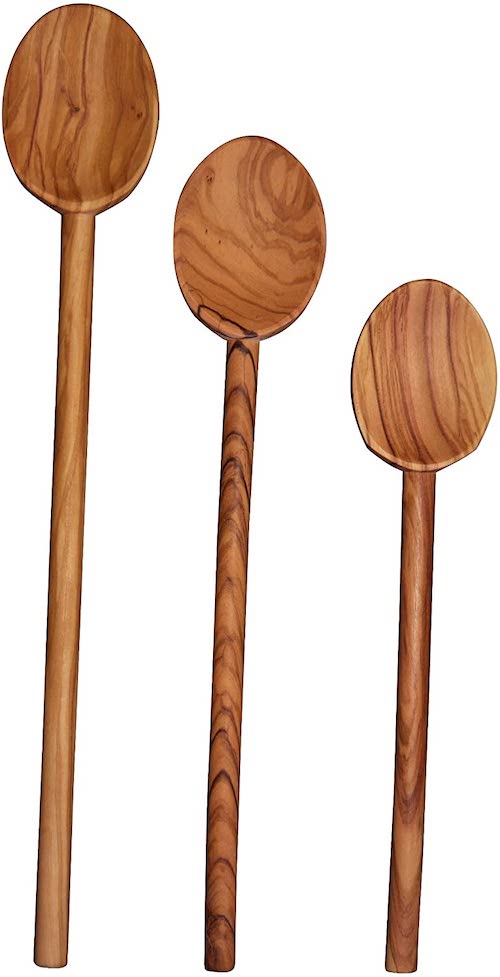STYLING WITH THE NEW “IT” KITCHEN COLLECTIBLE
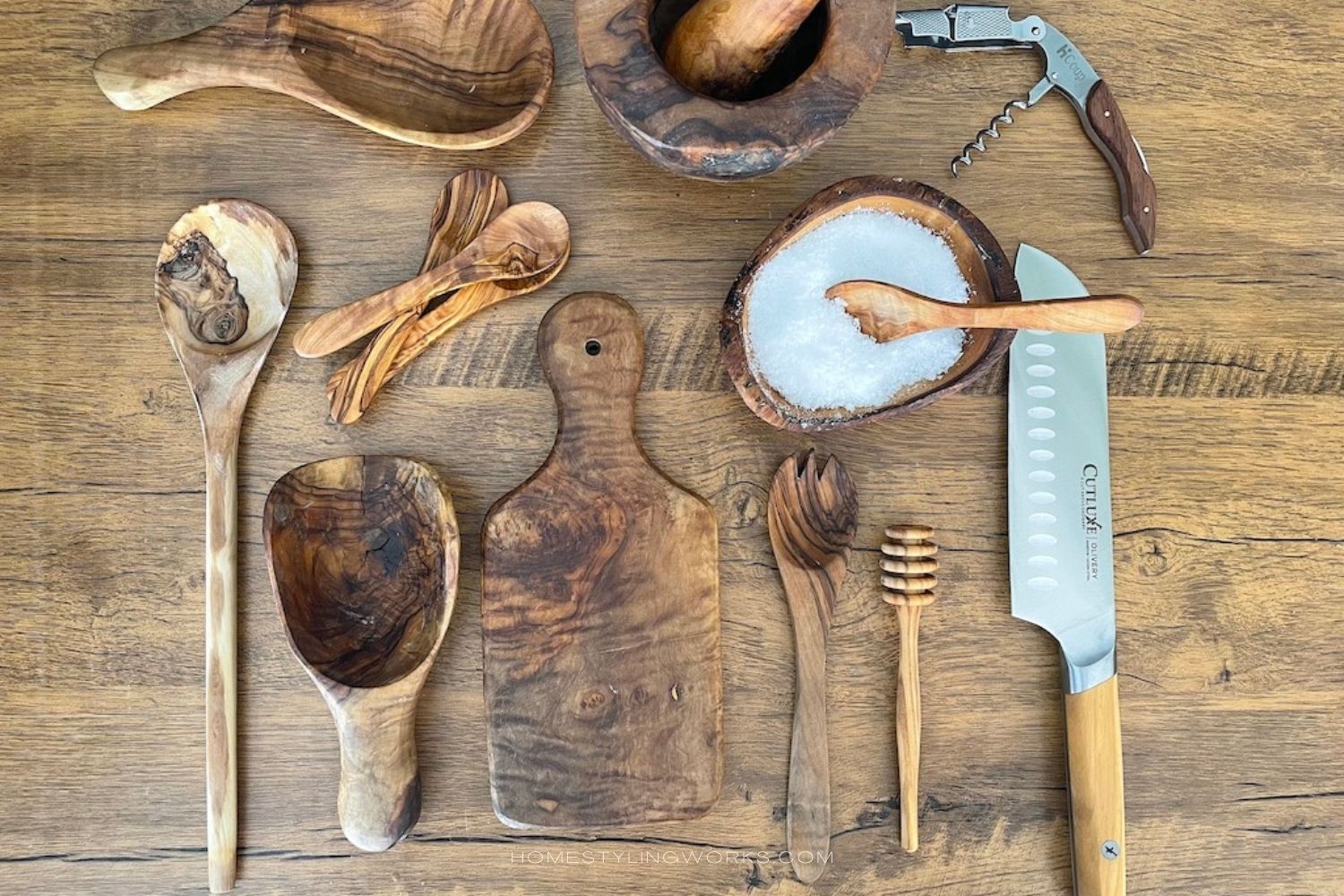
OLIVE WOOD OBJECTS IN THE KITCHEN
Today’s post is about collecting and styling with my favorite kitchen objects crafted from olive wood. Yes, THAT olive wood – sustainably sourced and harvested from olive trees in the Mediterranean. But these aren’t your run-of-the-mill wooden spoons, cheese boards and salad bowls. They’re works of art.
In today’s post, I’m going to share ideas for collecting, displaying and using these olive wood pieces in your own home.
I first spotted artisan olive wood utensils at a vendor in the famed markets of L’Isle-sur-la-Sorgue in Provence (below left). That was where I bought my first olive wood kitchen item – a beautiful scoop that I use in the kitchen (below right). That scoop started my collection of beautiful olive wood objects, which I use and display in my kitchen.
EUROPEAN ORIGINS
Olive wood artisans are found primarily in Italy and France, and many of these pieces are imported to the United States, making them very accessible. One of the best parts of collecting olive wood kitchenware is that it develops a patina over time, and looks even better with age (my olive wood scoop is 11 years old).
So let’s start with how I styled with olive wood pieces on a couple of editorial photo shoots.
OLIVE WOOD ON EDITORIAL PHOTO SHOOTS
I often brought olive wood objects to kitchen photo shoots that I produced, to add a textural element. In the Houston, TX kitchen below, designed by the talented Julie Dodson and photographed by Ryann Ford, I added the large olive wood board on the island and styled it with green broccoflower and a potted spirea plant. I also added an olive wood bowl to the open shelves, and leaned a couple of organic olive wood boards against the brick. We shot this for Traditional Home magazine, and that kitchen also made the cover.
In the kitchen below in Williamsville, NY that I designed and produced for Better Homes & Gardens “Kitchen and Bath Makeovers” magazine, I applied the same styling principle with stacked olive wood boards against the subway tile backsplash. Not just for show, I also styled an olive wood board with cheese and fruits. These are two very different styles of kitchens, which I chose to illustrate the versatility of olive wood pieces – they go in pretty much any style of kitchen.
So now we’ll delve a little bit into what makes olive wood objects so special.
What is Olive Wood?
Olive wood is wood harvested from Olea europaea and O. capensis, two types of olive trees that originate from southern and eastern Mediterranean countries in Europe and Eastern Africa. While olive trees are praised around the world for their fruit, the tree produces a dense wood that is hard, heavy and strong. Olive wood is prized for its appearance, density, straight grain and fine texture.
Olive trees can live for an exceptionally long time – the oldest known olive tree is 1500 years old! The average life span of an olive tree is 500 years old, and they can grow to over 100 feet in height – but 30-40 feet is the norm for mature trees.
Olive trees usually grow in a very gnarled and irregular way, with a large number of side branches twisting the trunk in many directions. That growth pattern makes extracting large and straight pieces of lumber difficult, which is why you don’t see too many olive wood floors.
Its grainy appearance lends itself to smaller objects such as kitchenware and utensils, which are often hand crafted by skilled artisans. The high density and cross grain of the wood can make it the manufacturing process more difficult, and no two pieces are alike (I love that aspect!) Olive wood also needs to be very slowly dried using a kiln-drying process at low heat levels. There’s a lot that goes into making a cutting board or a bowl.
A distinctive characteristic of olive wood is the contrasting brown lines and yellow streaks of sapwood.
ECO-FRIENDLY & SUSTAINABLE
With much thought about the environmental impacts of the products we use, the good news is that olive trees are not listed as a threatened species. Although it takes a long time for an olive tree to grow, it’s often a by-product of the agricultural industry, as eventually it stops producing fruit. Olive wood is harvested by not cutting down a whole tree, but rather pruning selected parts after the tree is no longer bearing fruit. So olive wood is not only beautiful, but sustainable, as well.
USEFUL & BEAUTIFUL
Olive wood is the best material for cooking utensils as they won’t scratch or damage your cookware. It’s more expensive than plastic, metal or bamboo because it’s durable, less porous, and overall stronger and more beautiful.
Olive wood is versatile and easy to work with, but even though it is hard and strong, it’s not used for outdoor applications (such as tables and chairs) since it lacks the ability to survive in the open for long periods of time.
Below I’m sharing a few of my favorite olive wood objects I use in my own kitchen.
OLIVE WOOD TOOLS
Here’s one of my favorite kitchen tools – an olive wood handled Santoku knife, reasonably priced at $45 (this was my Instagram & Facebook “Find of the Week” from the HSW Online Store last week). If you want to take the next jump in kitchen skills, here’s a professional higher-end olive wood handled Chef’s knife. They both come beautifully packaged and would make a great gift for an avid home cook.
Another favorite olive wood kitchen tool is this honey dipper (below).
I also have a few olive wood mortar and pestles, which are great for hand-grinding small amounts of spices. There are also links to a few favorites in the gallery at the bottom of the post.
OLIVE WOOD SPOONS
Probably the most practical of all olive wood tools, I collect beautiful olive wood spoons in various sizes, for cooking and serving.
Below: I love these mini olive wood spoons for serving condiments. They also make a great hostess gift, bundled together with some other olive wood items.
OLIVE WOOD BOARDS
The beauty of olive wood boards is in the imperfections. This is a clear mark of the artisan and how the wood has been artistically crafted to show the intricate lines of the wood. They come in a variety of sizes, and are too beautiful to hide away in a cupboard! These are meant to be displayed.
I also styled my outdoor tabletop with olive wood pieces below, from my post on Table Runners.
OLIVE WOOD BOWLS
Olive wood bowls in particular are true works of art – the wood bowl below has beautiful graining and elevates a simple green salad. I’ve included several sizes in the shopping gallery at the bottom of the post.
DISPLAYING & STYLING OLIVE WOOD OBJECTS
I always keep an olive wood bowl of kosher salt for cooking near the stove. This is a great spot to make a little “cooking vignette” in your kitchen – all these items such as olive oil, salt, pepper, fresh herbs and tasting spoons look great corralled on an olive wood board (or wood tray).
CARING FOR OLIVE WOOD OBJECTS
WASHING
To maintain the beauty of the wood, washing by hand is recommended – just a little mild soap and warm water does the trick. NEVER put olive wood pieces in the dishwasher, as it strips the wood of its natural beauty. Avoid soaking the objects in water because this could raise the grain and cause the wood to swell, leading to splitting over time. Rinse the pieces with warm water and instead of air drying, use a dish towel to wipe them dry.
TREATING
To preserve the olive wood’s natural grain, periodically rub with food safe oil. Mineral oil is a safe product that is easily absorbed and doesn’t leave the object feeling greasy. Place a small amount of the oil on a soft cloth, rub the oil over the entire utensil and allow it to soak into the wood. I use this oil on my olive wood pieces every few months.
MY CURATED OLIVE WOOD COLLECTION
CLICK ON THE IMAGES BELOW FOR PRODUCT LINKS IN THE HSW ONLINE SHOP
OLIVE WOOD COLLECTING & STYLING
As you can see, olive wood makes a great accent to every style of kitchen – and these objects also make lovely hostess and housewarming gifts. I hope this post has inspired you to Make Your Every Day More Beautiful® by styling your kitchen with beautiful olive wood objects!
For more ideas and inspirations, follow me on Instagram.

